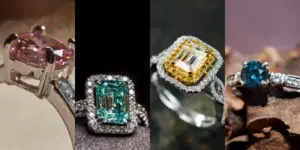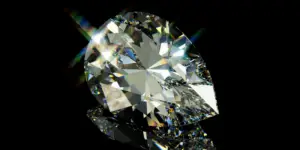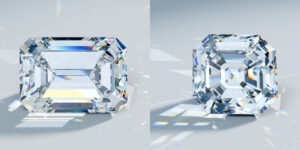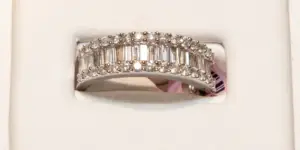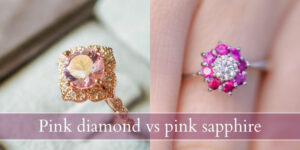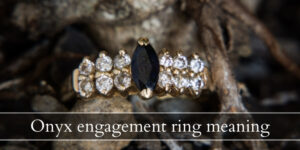Sapphires are probably the first gem you think of when we say ‘blue gemstones’. But in the past few years a rival has surfaced: tanzanite. By no means a newly discovered gem, but definitely a newcomer in the jewel industry. So how do you pick between these two irresistibly blue gems ? Which one is better for you ? And how do you even tell them apart ? Let’s compare the two gems in all things that matter, so yhou can have a clear idea.
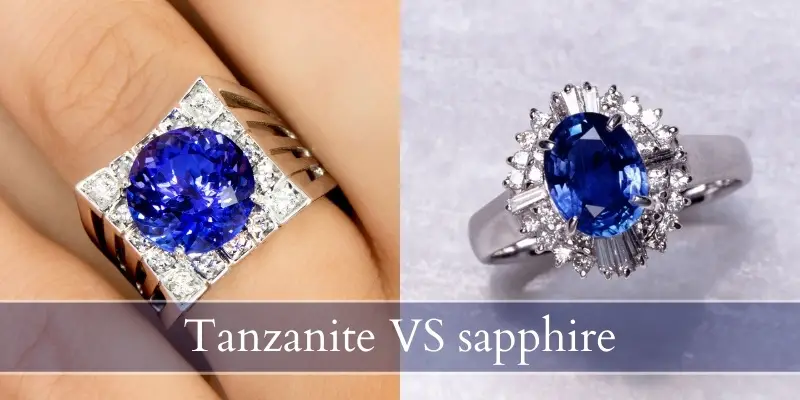
Tanzanite vs sapphire
Tanzanite is rarer than sapphire but more affordable in comparison. This is because tanzanite is a softer gem that scratches easier than sapphire, and it’s comparatively new to the jewelry market. Tanzanites are also eye-clean, while sapphires tend to be at least slightly included even after heat treatment. Tanzanite has slightly more violet in its body color, but the range is very wide so it can easily be confused with a sapphire unless you have one of each to compare.
What is tanzanite ?
Tanzanite is a type of zoisite, or rather the name given to the blue-violet version of zoisite. Zoisite is not extremely rare, but its blue version is. Tanzanite owes its blue-violet color to trace amounts of vanadium. This gem was brought into popularity by Tiffany&Co. and they were the ones to name it tanzanite, after the only country (Tanzania) where the blue-purple version is found.
What is sapphire ?
Sapphire is a type of corundum, most known for its cornflower blue version. Sapphires can in fact be any color such as teal, pink, yellow, orange, white, and black. But it’s the blue ones that have become the most famous. The only color you won’t find for sapphires is red, as those are always classed as rubies.
Now let’s get to comparing tanzanite and sapphires.
1. Tanzanite is rarer than sapphire
One of the key ways a gemstone is considered expensive, precious, a must-have is its rarity. This is the driving force behind many gems, including diamonds (despite them not truly being rare).
So it stands that tanzanite, the blue-violet version of zoisite, is in fact rarer than blue sapphires. Blue sapphires are the most common type of sapphire, while blue zoisite (tanzanite) is the rarest form.
But, sapphires are better known that tanzanite, as they were discovered thousands of years ago, while tanzanite was first discovered and analyzed in 1967.
Read also: Alexandrite VS Mystic Topaz
2. Sapphires are hard gems, better suited for daily wear
A gem’s hardness is what helps it resist scratches and chipping. This hardness is measured on a scale from 1 to 10, with diamond being a perfect 10, capable to withstand anything except another diamond.
So a sapphire has a hardness of 9. This means it will not scratch, unless hit by moissanite (9.25) or diamond (10), or another sapphire or ruby. This makes it a very good choice for everyday wear, as the gem will look the same even several decades later. Normally you wouldn’t need to have the stone re-polished as there should be no scratches in time.
A tanzanite is a softer gem, scoring a 6.5 on the Mohs scale. This means it will scratch and possibly chip if worn daily, unless you take very good care to keep it out of harm’s way. All gems above 7 are rated as acceptable to wear every day, but the higher the score the better the gem will stand the test of time. So if you do want to get tanzanite, make sure it is a pendant or earrings, as those rarely hit anything so they won’t easily scratch.
Or, if you do want a ring or bracelet, restrict wearing them only to formal events or special occasions. This way you lessen the chances of them accumulating any scratches.
3. Tanzanites tend to be eye-clean, sapphires are included
When you’re looking at colored gems, you have to know that the grading system is different. Rather, there is no standardized method to grade color and clarity. But in general you’ll notice that sapphires are a bit cloudy, or included. Some specimens have inclusions that reach all the way up to the surface of the gemstone. Those will always be cheaper as they’re sub-standard.
Tanzanites are eye-clean when you look at them, meaning they appear clear to the naked eye, though they may have inclusions when examined by a jeweler.
In the case of step-cuts, where clarity is important, this matters a lot. Tanzanites would perform better than sapphires, and for a lower price. It also matters for brilliant cuts, though neither sapphire nor tanzanite benefit from such a cut as they’re not sparkly. The lighter colored ones would show up better in a brilliant cut.
4. Sapphires are more expensive than tanzanites
Lastly, we have the price point to look at. Sapphires outclass tanzanites, despite tanzanite’s rarity. A sapphire will always be expensive because it shows beautiful color but is also a hard gemstone, making it the perfect choice for fine jewelry that would be passed down for generations to come.
So a perfectly colored blue sapphire can sell for about $1500 per carat, possibly more if the cut is perfect and there are no major inclusions. Naturally blue sapphires (not treated) are usually double the price per carat.
Meanwhile perfectly clear tanzanite with a great color can sell for $100-300, depending on the exact color, and cut quality. For example cabochons always sell for far less than brilliant or step cuts, but they also have a poorer color.
Similarities between sapphire and tanzanite
Despite their differences, tanzanites and sapphire are still similar, at least in terms of color and that’s something to keep in mind if you only need the color of the gem, not its other properties. So here’s a quick rundown on their similarities, and also how to tell them apart.
Both tanzanite and sapphire are heat-treated for color
If you’re looking for a gem that is 100% natural, and the blue you see is the same blue the gem came out of the earth, you’ll be disappointed. The vast majority of tanzanite and sapphires are heat-treated to get an intense blue color.
For sapphires this heat treatment is standard and will always be stated on the label. One key way to notice this by just looking at the gem is its clarity. If it’s a very clear and very blue sapphire but doesn’t sell for more than $1500 per carat, it’s most likely a heat-treated gem. Treat treatment dissolves the rutile inclusions in sapphire, which appear whitish.
Tanzanite comes out of the earth a bit blue, just like sapphire, but it needs a heat treatment to develop its color further into the deep blue-violet you usually see.
Both sapphire and tanzanite have a deep blue, indigo color
The color of a good sapphire can be mistaken with a tanzanite in many cases. Where sapphire are cornflower blue – the slightest hint of violet – tanzanites are blue with a more noticeable violet hue. Still this is hard to detect by looking at a single gem. It’s far easier to tell them apart if you have them next to each other.
How to tell a tanzanite from a sapphire
Despite there very similar colors, there is one thing a tanzanite can do that a sapphire can: show blue, purple, and red flashes all in the same gem. A very fine sapphire will show a blue body with violet flashes, but never red.
Also tanzanite will appear more purple in indoor lighting, simply because it can reflect more red light than sapphire. When you take tanzanite to outdoor lighting, it will appear just as blue as a regular sapphire.
Blue alternatives for sapphire and tanzanite
Don’t really feel like tanzanite or sapphire ? Or perhaps you can’t find either ? There are a few options you might want to consider, and they’re pretty similar in color both to sapphire and tanzanite. Some of these may prove more affordable or easier to find. So let’s take a look.
Iolite
Also known as cordierite, this is a very special gemstone, in that it’s a common substitute for sapphire but also changes color depending on the light. It can go from violet-blue to grey to yellowish grey and then light blue, depending on the angle of the light. Most of the time it will appear as dark blue-violet.
Blue spinel
Blue spinel has a wider range of blue, as it can span from grey-blue to greenish blue to cornflower blue, to deep, violet blue. This gem usually has very good clarity and is tougher than tanzanite but softer than sapphire.
Benitoite
Benitoite is not a common gem by any means, but it’s very similar to sapphires and tanzanites in color. It can be a bit difficult to get a hold of, but if you really want something special, there you go. This gem is softer than a sapphire, at times even a bit softer than tanzanite (6-6.5) so you might wan tot restrict it to occasional wear.

I’m the main author for jewelrymaterialguide.com. I started this site after we did tons of research before our wedding and noticed that there is information about rings, jewelry, and so on that is really hard to find on the internet.

